
Petroleum Meeting 2017

Theme: Fuelling the Innovations and Advancements in Petroleum Engineering
Petroleum geology is the study of the origin, natural occurrence, movement, gathering and exploration of hydrocarbon fuels, especially oil or petroleum. Petroleum geology involves sedimentology, the study of how sand, mud and clay are deposited. The majority of rocks found on the Earth's surface are sedimentary rocks. Studying sedimentology helps petroleum geologists understand how the petroleum deposits found in sedimentary rocks came to be because it is in sedimentary basins that the commercial accumulations of petroleum occur.
A sedimentary basin may be defined as an area in which sediments accumulate during a particular time span at a significantly greater rate and so to a significantly greater thickness than in the surrounding areas. This is not entirely satisfactory because of the vagueness about thickness-yet this vagueness exists. The essential part of any definition must be the accumulation of sediment relative to neighboring areas and its relative rather than absolute thickness. Another aspect of petroleum geology is stratigraphy, the study of the relationship between rock layers and the way they can move or shift. The movement of rock layers can affect where petroleum deposits are found, as well as the removal of the petroleum
Geophysical Exploration is the application of the principles of Physics to the study of the subsurface, in search of hydrocarbon. Geophysical investigations of the interior of the earth involve taking measurements at or near earth’s surface that are influenced by the internal distribution of physical properties. The objective of any exploration venture is to find new volumes of hydrocarbons at a low cast and in a short span of time. The usual sequence of activities once an area has been selected for exploration starts with the definition of a basin. Petroleum exploration and production are concerned with the geological interpretation of geophysical data, especially in offshore areas.
Hydraulic Fracturing is the process of pumping fluid into a wellbore at an injection rate that is too high for the formation to accept without breaking. During injection the resistance to flow in the formation increases, the pressure in the wellbore increases to a value called the break-down pressure that is the sum of the in-situ compressive stress and the strength of the formation. Once the formation “breaks down,” a fracture is formed, and the injected fluid flows through it. From a limited group of active perforations, ideally a single, vertical fracture is created that propagates in two "wings" being 180° apart and identical in shape and size. In naturally fractured or cleated formations, it is possible that multiple fractures are created and/or the two wings evolve in a tree-like pattern with increasing number of branches away from the injection point.
4.Advanced Drilling Technologies
Drilling is a unique mechanical process that is designed to bring petroleum oil hydrocarbons to the surface by making a hole or bore into the earth’s surface. In geotechnical engineering, drilling fluid is used to aid the drilling of boreholes into the earth. Drilling rigs are used not only to identify geologic reservoirs but also to create holes that allow the extraction of oil or natural gas from those reservoirs. Traditionally oil and gas wells are vertically drilled. Technological advancements have allowed operators to save time, reduce operational costs, and lessen their environmental impact.
Petroleum refinery is an industrial process plant where crude oil is processed and refined into more useful products such as petroleum naphtha, gasoline, diesel fuel, asphalt base, heating oil, kerosene, and liquefied petroleum gas. Oil refineries are typically large, sprawling industrial complexes with extensive piping running throughout, carrying streams of fluids between large chemical processing units. In many ways, oil refineries use much of the technology of, and can be thought of, as types of chemical plants. The crude oil feed stock has typically been processed by an oil production plant. There is usually an oil depot (tank farm) at or near an oil refinery for the storage of incoming crude oil feedstock as well as bulk liquid products. An oil refinery is considered an essential part of the downstream side of the petroleum industry.
Unprocessed crude oil is not generally useful in industrial applications, although "light, sweet" (low viscosity, low sulfur) crude oil has been used directly as a burner fuel to produce steam for the propulsion of seagoing vessels. The lighter elements, however, form explosive vapors in the fuel tanks and are therefore hazardous, especially in warships. Instead, the hundreds of different hydrocarbon molecules in crude oil are separated in a refinery into components which can be used as fuels, lubricants, and as feedstock in petrochemical processes that manufacture such products as plastics, detergents, solvents, elastomers and fibers such as nylon and polyesters.
6.Computer Applications in Petroleum Engineering
Petroleum Engineering makes use of technology in a variety of ways depending on the specialization area. The reason for this is because the ability to extract hydrocarbons has become more complex as the terrain has become more difficult including deep-water, arctic and desert conditions. Therefore, new solutions have had to be constructed in order to access these hard to reach deposits and this means that Petroleum Engineers need to understand different areas such as thermo-hydraulics, geo-mechanics and intelligent systems. As a result petroleum engineering technology applications have played an increasing role in aiding engineers in their work. Petroleum engineering technology continues to improve and there have been advances in computer modelling and simulation, statistical and probability analysis, as well new technical innovations such as horizontal drilling and enhanced oil recovery. These applications and technologies have substantially improved the tools used by the Petroleum Engineer in recent years, and they will continue to play an important part in their activities as they seek to research and develop new ways to extract new deposits, while lowering the cost of drilling and production.
7.Computational Modeling Techniques
Monte Carlo simulation is a process of running a model numerous times with a random selection from the input distributions for each variable. The results of these numerous scenarios can give you a "most likely" case, along with a statistical distribution to understand the risk or uncertainty involved. Computer programs make it easy to run thousands of random samplings quickly.
Like tornado charts, a spider diagram is a traditional but limited. Again, one holds fixed all but one variable and examines how the output changes (usually measured as a percent change) as we vary that one input (usually by a few specific percentages). Typically, we might vary each input by 5, 10, and 20% and see how much the output changes. Often the percent change is not linear, causing the resulting graph to have broken line segments, accounting for the name: spider diagram.
8.Petroleum Desulphurization Techniques
Sulphur exists in crude petroleum as a non-hydrocarbon constituent in different concentrations. Among the distillate fractions obtained from crude oil, the distribution of sulphur compounds is not uniform, rather it vary from fraction to fraction depending upon their boiling points. The concentration as well as the complexity in the structure of the sulphur compounds increases in various distillate fractions with the increase in boiling points. In petroleum its presence is undesirable due to corrosion problems, deactivating catalysts in various refining processes and contributing to environmental pollution. So the regulation authorities are imposing strict regulations to limit the amount of sulphur in petroleum based liquid fuels.
Concerning the detrimental effects of sulphur compounds in the form of environmental pollutant, health effect and hurdling in the refining processes, it is important to remove sulphur from petroleum derived fuels prior to their usage for energy. Sulphur compounds are removed from petroleum and petroleum derived products through the process as desulphurization process. Today hydrodesulphurization (HDS) is the only process used by refineries worldwide for desulphurization of petroleum, but researchers are introducing new techniques which are more efficient and cost effectives than HDS.
9.Reservoir Engineering & Reservoir Simulation
Reservoir Engineering involves assessing oil and gas deposits. Reservoir Engineers firstly estimate the size of a reservoir, then determine how much oil and gas reserves are in the reservoir and finally work out how to maximize the economic return from extracting them. They work together with geologists and geophysicists to find the reserves of oil and gas while relying on the basic laws of physics and chemistry. These include applying the behavioural effects of liquid and vapour phases of oil, natural gas, and water in rock. The next step is to determine the economic feasibility of extracting the gas. The ultimate responsibility of the reservoir engineer is to maximize the output of the reservoir without causing overproduction.
Reservoir simulation is an area of reservoir engineering in which computer models are used to predict the flow of fluids (typically, oil, water, and gas) through porous media. Reservoir simulation models are used by oil and gas companies in the development of new fields. As building and maintaining a robust, reliable model of a field is often time-consuming and expensive, models are typically only constructed where large investment decisions are at stake. Improvements in simulation software have lowered the time to develop a model.
10.Advanced Natural Gas Engineering
Natural gas is a subcategory of petroleum which is naturally occurring complex mixture of hydrocarbons, with a minor amount of inorganic compounds. Geologists and chemists agree that petroleum originates from plants and animal remains that accumulate on the sea floor along with the sediments that form sedimentary rocks. The contributing factors are thought to be bacterial action; shearing pressure during compaction, heat and natural distillation at depth; possible addition of hydrogen from deep-seated sources; presence of catalysts. Because natural gas is petroleum in a gaseous state, it is always accompanied by oil that is liquid petroleum. Non associated gas is from reservoirs with minimal oil. Associated gas is the gas dissolved in oil under natural conditions in the oil reservoir. Gas condensate refers to gas with high content of liquid hydrocarbon at reduced pressures and temperatures. Natural gas reserves include Proved reserves and Potential resources. Proved reserves are the quantities of gas that have been found by the drill. Potential resources constitute those quantities of natural gas that are believed to exist in various rocks of the Earth’s crust but have not yet been found by drill.
11.Petrophysics & Petrochemistry
Petrophysics is the study of physical and chemical rock properties and their interactions with fluids. A major application of Petrophysics is in studying reservoirs for the hydrocarbon industry. Petrophysicists are employed to help reservoir engineers and geoscientists understand the rock properties of the reservoir, particularly how pores in the subsurface are interconnected, controlling the accumulation and migration of hydrocarbons. Some of the key properties studied in Petrophysics are lithology, porosity, water saturation, permeability and density. A key aspect of Petrophysics is measuring and evaluating these rock properties by acquiring well log measurements - in which a string of measurement tools are inserted in the borehole, core measurements - in which rock samples are retrieved from subsurface, and seismic measurements.
Petrochemistry is a branch of chemistry that studies the transformation of crude oil (petroleum) and natural gas into useful products or raw materials. These petrochemicals have become an essential part of the chemical industry today.
12.New frontiers in Petroleum Engineering
Petroleum engineering is considered as a relatively new among other engineering disciplines. Due to the need for a specialized petroleum engineering science, its pillars were set by mining engineers, geologists, mechanical engineers, civil engineers and many other contributors. The boundaries of petroleum engineering are well defined in the first quarter of the twentieth century. In 1915, specialized petroleum engineering programs were established in the United States universities followed by other universities worldwide. From that time petroleum engineering science was rapidly growing and evolving to provide the humanity with the power source for the modern technology.
As demand for oil and its derivatives is increasing, education, research, and technology are also rapidly developing to drive the oil and gas sector forward by developing new technical solutions, standards and industry best practices.
13.Major Challenges in Petroleum Industry
Over the last twenty years the field of Petroleum Engineering has undergone major changes. The evolution of technology as well as the increasing presence of computerized tools in nearly all stages of the exploration-production processes. Petroleum Industry demands from our possible future leaders and managers a basic understanding of the oil business, the global market, its trends, risks and economical implications. Knowledge about major oil and service companies and their markets and geographic areas of operation is also necessary since, as it is well known, professional development and promotions often come with reallocation to a different region or country. In addition, modern professionals will be asked to be well-informed about legal and ethics issues and have an awareness of matters related to health, safety and environment.
The Exploration and Production in Petroleum industry faces numerous challenges as it addresses growing energy demand, the need for sustainable operations, declining production from older reservoirs, and new resources is harder to reach and harsher environments. The Society for Petroleum Engineers Research & Development Committee identified five grand challenges for the industry and is developing white papers for each one that describe the challenge, the current state of R&D, and areas for further research.
14.Environmental Impacts in Petroleum Engineering
Petroleum-derived contaminants constitute one of the most prevalent sources of environmental degradation in the industrialized world. In large concentrations, the hydrocarbon molecules that make up crude oil and petroleum products are highly toxic to many organisms, including humans. Petroleum also contains trace amounts of sulfur and nitrogen compounds, which are dangerous by themselves and can react with the environment to produce secondary poisonous chemicals. The dominance of petroleum products in the United States and the world economy creates the conditions for distributing large amounts of these toxins into populated areas and ecosystems around the globe. The environmental impact of petroleum is often negative because it is toxic to almost all forms of life and its extraction fuels climate change. Petroleum, commonly referred to as oil, is closely linked to virtually all aspects of present society, especially for transportation and heating for both homes and for commercial and industrial activities.
The scale of global fossil fuel consumption is massive. While fossil fuel consumption continues to increase to sustain our growing population and the advancement of developing nations most of this increase in consumption comes from coal and natural gas. Coal and gas production rates are currently increasing faster than consumption rates. For petroleum oil however, consumption has grown faster than oil production in the same period largely due to the plateau in production of conventional oil; a harbinger of some major challenges and changes to the future energy mix. The petroleum industry can exploit a range of feedstock for the production, processing and transformation of liquid hydrocarbons, of which conventional oil has, until recently, been the cheapest and most readily accessible. A significant factor in the choice of future feedstock will be the impact on global CO2 emissions for which targets have been set by many governments suggesting a trend that is likely to increase. If effective, these targets would impose a market premium increasingly favoring CO2-neutral feedstock, including fuels derived from algae.
Petroleum Economics is about how oil and gas activities are driven by economic considerations, and how the values are shared. Just about anyone working with the petroleum sector needs to understand some fundamentals of its economics. Petroleum Economics has a vital role to play in the Oil & Gas Industry and it lies at the heart of all decision making. Various techniques have evolved over time in determining and calculating economic inputs, evaluating investments, quantifying risk and generating feasible portfolios. Petroleum Economics brings together information and expertise across the E&P spectrum and a clear understanding of concepts such as cash flow analysis, organizational challenges, price forecasting, cost drivers and risk management is required. This training event aims to bring together a wide industry audience including practitioners of economics and decision making, petroleum engineers & geoscientists and offers structured short interactive training sessions on topics such as Economic Modeling, Decision Analysis, Exploration Analysis and Economics of Unconventional Resources.
About Conference:
Meetings International welcomes you to attend the International Meeting on Petroleum Engineering which is to be held during November 16-17, 2017 Singapore, Malaysia. Special interest and theme of the conference is “Fuelling the Innovations and Advancements in Petroleum Engineering”.
Petroleum Meetings 2017 Prime motto is to address the challenges in addressing growing energy demands, the need for sustainable operations, declining production from older reservoirs, and new resources is harder to reach and harsher environments. Petroleum Meetings 2017 conference prepares a ground for seeding new ideas and nurturing knowledge through discussions and analysis on advancements in Petroleum Engineering.
Why to Attend???
Petroleum Meetings 2017 conference is a multidisciplinary program with broad participation of members from around the globe focused on learning about innovations and advancements in Petroleum Engineering. This is your best opportunity to reach the largest assemblage of participants from Petroleum Engineering community that is from academia, research entities, petroleum societies, related associations, and also from government agencies, exploration and production industries.
Petroleum Meetings 2017 will discuss various disciplines involved in the Petroleum Engineering research activities related to the production of hydrocarbons, which can be either crude oil or natural gas. Exploration and Production are deemed to fall within the upstream sector of the oil and gas industry. Exploration, by earth scientists, and petroleum engineering are the oil and gas industry's two main subsurface disciplines, which focus on maximizing economic recovery of hydrocarbons from subsurface reservoirs. Petroleum geology and geophysics focus on provision of a static description of the hydrocarbon reservoir rock, while petroleum engineering focuses on estimation of the recoverable volume of this resource using a detailed understanding of the physical behavior of oil, water and gas within porous rock at very high pressure. This conference conducts presentations, distribute information, meet with current and potential scientists, make a splash with new research developments, and receive name recognition at this 3-days event. World renowned speakers and the most recent techniques, developments, the latest innovations and advancements in Petroleum Engineering.
Who Should Attend and Whom You’ll Meet
Petroleum Engineering conference aims at multi-disciplined audience with diverse commercial, technical, corporate, operations, planning sectors of the upstream oil and gas engineering services. Meet Your Target Market with members from around the world focused on learning and sharing about Upstream Scientists/Engineers; this is your single best opportunity to reach the largest assemblage of participants from the global Oil and gas engineering industry. World-renowned speakers, the most recent techniques, tactics, and the newest breakthroughs in the upstream sector of oil and gas engineering are hallmarks of this conference.
· Petroleum Engineers
· Scientists , Researchers & Technical Staff from petroleum engineering field.
· Professors, Students & Delegates from petroleum engineering Department
· Geologists, Geophysicists, Reservoir Engineers, Production Engineers, Chemical Engineers.
Directors/Senior Directors/Executive Directors and Vice Presidents/Senior Vice Presidents/Executive Vice Presidents and Heads/Leaders/Partners of
The American Institute of Mining, Metallurgical, and Petroleum Engineers, Geologists associations, US Oil and Gas Association, The Society of Petroleum Engineers.
Academicians: University Faculties like Directors, Senior Professors/Assistant Professors/ Associate Professors, Research Scholars, scientists who are related to Petroleum Engineering.
· Petroleum Engineers
· Scientists, Researchers & Technical Staff from petroleum engineering field.
· Professors, Students & Delegates from petroleum engineering Department
· Geologists, Geophysicists
· Reservoir engineers, production engineers
· Chemical Engineers
· Production engineers are the Potential Exhibitors for the Respective Conferences.
· The American Institute of Mining, Metallurgical, and Petroleum Engineers
· Geologists associations, US Oil and Gas Association, The Society of Petroleum Engineers
Top Universities in Singapore :
· National University of Singapore
· Nanyang Technological University
· Curtin University of Technology
· Singapore Institute of Technology
· Nanyang University
· GlobalNxt University
· University of Nevada Las Vegas Singapore
· University of New South Wales Asia
Major petroleum engineering Research Associations around the Globe :
· American Association of Petroleum Geologists
· American Institute of Mining, Metallurgical, and Petroleum Engineers
· Canadian Association of Oilwell Drilling Contractors
· Canadian Association Of Petroleum Producers
· Pennsylvania Petroleum Association
· American Fuel and Petrochemical Manufacturer
· Society of Petroleum Engineers
· Independent Petroleum Association of America
· American Association of Petroleum Geologists
· The Petroleum Marketers Association of America
· US Oil and Gas Association
· Petroleum Motor Transport Association
· The Petroleum Marketers Association of America
· Japanese Association for Petroleum Technology
· Independent Petroleum Association of America
Major Oil & Gas Companies around the Globe:
· Sinopec
· China National Petroleum Corp. (Petrochina)
· Royal Dutch Shell
· ExxonMobile
· Saudi Arabian Oil Company (Aramco)
· BP
· Total S.A.
· Kuwait Petroleum Corp
· Chevron Corporation
· OJSC Lukoil
The petroleum industry in Singapore is accountable for part of the country's economy, exporting about 68,100,000 tonnes (67,000,000 long tons; 75,100,000 short tons) of oil (as of 2007). Singapore is dubbed "the undisputed oil hub in Asia", with the country's oil industry responsible for five percent of the country's gross domestic product (GDP). The petroleum industry in Singapore dates back to 1891. In 2007, the country exported approximately 68.1 million tons of petroleum. The same year, the Singaporean government published a report titled Energy for Growth, describing how the industry would be sustained. Singapore is described as "the undisputed oil hub in Asia". The oil industry is responsible for some five percent of the country's gross domestic product (GDP). It generated an estimated S$57 billion dollars in 2009. Technology used for oil refinement and trading centres in Singapore is on the cutting edge, and many well-established petroleum businesses, such as Exxon Mobil and Lanxess, are based in Singapore, owing to the country's "safe environment" and ideal trading location.
Singapore Refined Petroleum Products Exports :
The petroleum industry includes the global processes of exploration, extraction, refining, transporting (often by oil tankers and pipelines), and marketing of petroleum products. The largest volume products of the industry are fuel oil and gasoline (petrol). Petroleum (oil) is also the raw material for many chemical products, including pharmaceuticals, solvents, fertilizers, pesticides, synthetic fragrances, and plastics.Petroleum is vital to many industries, and is of importance to the maintenance of industrial civilization in its current configuration, and thus is a critical concern for many nations. Oil accounts for a large percentage of the world’s energy consumption, ranging from a low of 32% for Europe and Asia, to a high of 53% for the Middle East.
Implied global petroleum and liquid fuels inventories are estimated to have increased by 0.8 million barrels per day (b/d) in 2016. EIA expects the oil market to be relatively balanced in 2017 and 2018, with inventory draws averaging 0.1 million b/d in 2017 and builds averaging 0.2 million b/d in 2018. The revised forecast, which reduces average inventory builds from last month's outlook, resulted from changes to estimates of historical global liquid fuels consumption that created a higher base for consumption during recent years and the forecast period.EIA forecasts Brent crude oil prices to average $55/b in 2017 and $57/b in 2018. West Texas Intermediate (WTI) crude oil prices are forecast to average about $1/b less than Brent prices in 2017. The NYMEX contract values for April 2017 delivery traded during the five-day period ending February 2 suggest that a range from $45/b to $65/b encompasses the market expectation of WTI prices in April 2017 at the 95% confidence level.
Petroleum Production in the World from 1980-2120 :
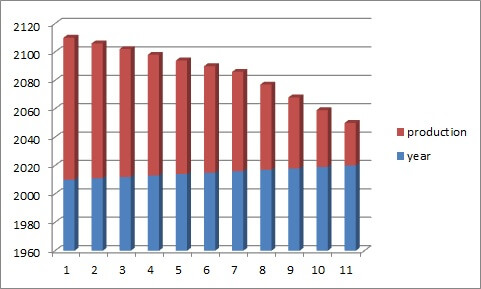
Global economic growth impacts world oil consumption and oil prices. Commercial and personal transportation activities require large quantities of oil. Oil is also used in manufacturing processes and for power generation. The rise in crude oil production from non-OPEC producers between 2013 and 2015 led to oversupply in the crude oil market. Crude oil prices collapsed during 2014 and 2015. Lower crude oil prices supported consumption along with steady economic growth in 2015 and 2016. Steady world oil consumption supported by steady global economic growth would support oil prices in 2017. The change in world consumption is expected to average 1.6% in 2017—compared to 1.6% in 2016. Global GDP is expected to average 2.7% in 2017—compared to 2.2% in 2016. For updates on the world oil supply and demand gap in 2017, read the previous part of this series.
World Petroleum Consumption 2014 :
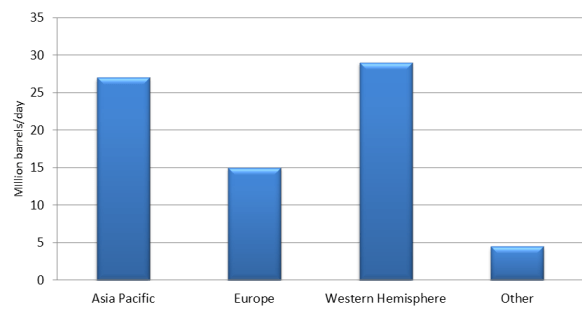
The Organization of Economic Cooperation and Development (OECD) consists of the United States, much of Europe, and other advanced countries. At 53 percent of world oil consumption in 2010, these large economies consume more oil than the non-OECD countries, but havStructural conditions in each country's economy influence the relationships among oil prices, economic growth, and oil consumption. Developed countries tend to have higher vehicle ownership per capita. Because of this, oil use within the OECD transportation sector usually accounts for a larger share of total oil consumption than in non-OECD countries; it is also more mature and slower-growing. Economic conditions and policies that affect the transport of goods and people thus have a significant impact on total oil consumption in OECD countries. Many OECD countries have higher fuel taxes and policies to improve the fuel economy of new vehicles and increase the use of biofuels. e much lower oil consumption growth.
OECD Consumption in Quadrillion Btu :
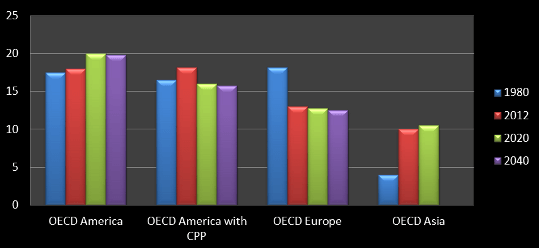
The OPEC Reference Basket (ORB), also referred to as the OPEC Basket, is a weighted average of prices for petroleum blends produced by OPEC members. It is used as an important benchmark for crude oil prices. OPEC has often attempted to keep the price of the OPEC Basket between upper and lower limits, by increasing and decreasing production. This makes the measure important for market analysts. The OPEC Basket, including a mix of light and heavy crude oil products, is heavier than both Brent crude oil, and West Texas Intermediate crude oil.
OPEC Basket Price in U$ :
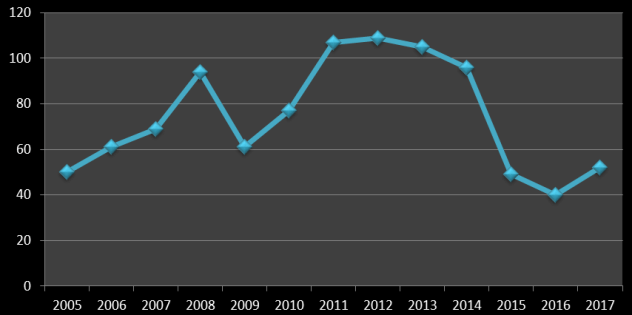
Demand for oil is expected to grow even more slowly beyond 2025, with the research pointing to a possible peak of 100m barrels a day by 2030, from current levels of 94m. The industry is mired in debt after the plunge in oil prices in recent years. Meanwhile growth in electricity demand will outstrip other sources of energy by more than two to one, due to the steady “electrification” of building and industry in China and India. Global oil demand could peak by the end of the next decade even as global economic growth climbs.
Oil Demand 2010 Vs 2030 (mb/d) :
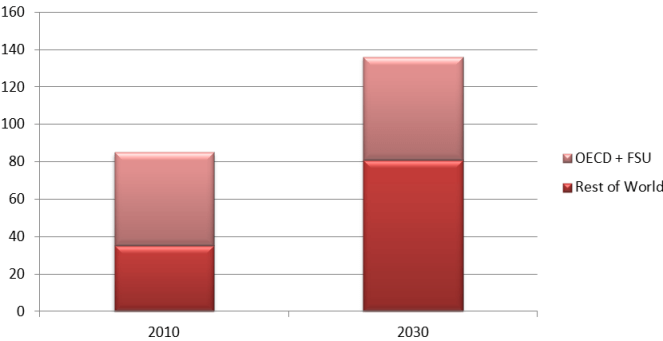
Having great natural resource endowments brings with it great benefits - and even greater responsibilities and challenges. OPEC's Member Countries understand this and are dedicated to market stability. OPEC is committed to continuous investment and ensuring more supply to the world's oil markets. One scenario could be for a producing country to not depend solely on oil and gas as its main source of revenue and, consequently, leave the majority of these resources in the ground. Of course, the risk is that if there is any unexpected supply crunch, the country may not be able and ready to meet a possible shortfall. Oil producers have experienced this situation before. The other scenario could be for a country to focus strongly on upstream investments - with the goal of expanding capacity and generating more money, despite its needs.
OPEC Upstream Investment Plans :
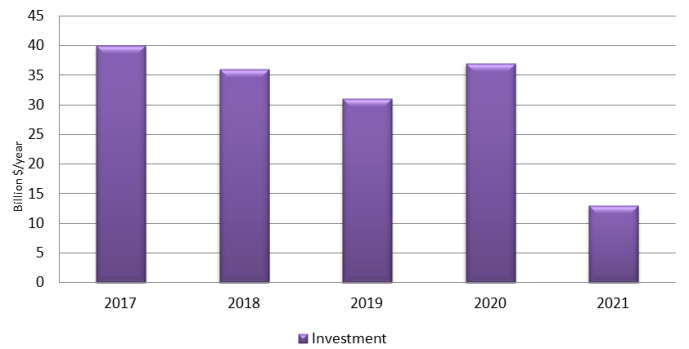
- Petroleum Geology
- Geophysical Exploration
- Hydraulic Fracturing
- Advanced Drilling Technologies
- Petroleum Refineries
- Computer Applications in Petroleum Engineering
- Computational Modelling
- Petroleum Desulphurization
- Reservoir Engineering & Reservoir Simulation
- Advanced Natural Gas Engineering
- Petrophysics & Petrochemistry
- New frontiers in Petroleum Engineering
- Major Challenges in Petroleum Industry
- Environmental Impacts in Petroleum Engineering
- Petroleum Substitutes
- Petroleum Economics
- Journal of Environmental Research
- Journal of Petroleum & Environmental Biotechnology
- Journal of Oil & Gas Research
- Journal of Chemical Engineering & Process Technology































































































































